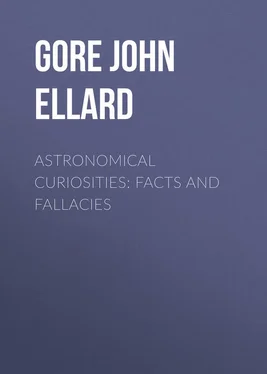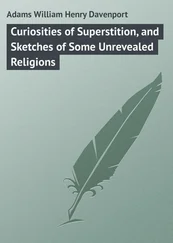John Gore - Astronomical Curiosities - Facts and Fallacies
Здесь есть возможность читать онлайн «John Gore - Astronomical Curiosities - Facts and Fallacies» — ознакомительный отрывок электронной книги совершенно бесплатно, а после прочтения отрывка купить полную версию. В некоторых случаях можно слушать аудио, скачать через торрент в формате fb2 и присутствует краткое содержание. Жанр: Физика, foreign_antique, foreign_prose, на английском языке. Описание произведения, (предисловие) а так же отзывы посетителей доступны на портале библиотеки ЛибКат.
- Название:Astronomical Curiosities: Facts and Fallacies
- Автор:
- Жанр:
- Год:неизвестен
- ISBN:нет данных
- Рейтинг книги:5 / 5. Голосов: 1
-
Избранное:Добавить в избранное
- Отзывы:
-
Ваша оценка:
- 100
- 1
- 2
- 3
- 4
- 5
Astronomical Curiosities: Facts and Fallacies: краткое содержание, описание и аннотация
Предлагаем к чтению аннотацию, описание, краткое содержание или предисловие (зависит от того, что написал сам автор книги «Astronomical Curiosities: Facts and Fallacies»). Если вы не нашли необходимую информацию о книге — напишите в комментариях, мы постараемся отыскать её.
Astronomical Curiosities: Facts and Fallacies — читать онлайн ознакомительный отрывок
Ниже представлен текст книги, разбитый по страницам. Система сохранения места последней прочитанной страницы, позволяет с удобством читать онлайн бесплатно книгу «Astronomical Curiosities: Facts and Fallacies», без необходимости каждый раз заново искать на чём Вы остановились. Поставьте закладку, и сможете в любой момент перейти на страницу, на которой закончили чтение.
Интервал:
Закладка:
From his researches on the cause of the Precession of the Equinoxes, Laplace concluded that “the motion of the earth’s axis is the same as if the whole sea formed a solid mass adhering to its surface.” 71 71 Quoted by Grant in History of Physical Astronomy , p. 71.
Laplace found that the major (or longer) axis of the earth’s orbit coincided with the line of Equinoxes in the year 4107 B.C. The earth’s perigee then coincided with the autumnal equinox. The epoch at which the major axis was perpendicular to the line of equinoxes fell in the year 1250 A.D. 72 72 Ibid. , pp. 100, 101.
Leverrier has found the minimum eccentricity of the earth’s orbit round the sun to be 0·0047; so that the orbit will never become absolutely circular, as some have imagined.
Laplace says —
“Astronomy considered in its entirety is the finest monument of the human mind, the noblest essay of its intelligence. Seduced by the illusions of the senses and of self-pride, for a long time man considered himself as the centre of the movement of the stars; his vain-glory has been punished by the terrors which his own ideas have inspired. At last the efforts of several centuries brushed aside the veil which concealed the system of the world. We discover ourselves upon a planet, itself almost imperceptible in the vast extent of the solar system, which in its turn is only an insensible point in the immensity of space. The sublime results to which this discovery has led should suffice to console us for our extreme littleness, and the rank which it assigns to the earth. Let us treasure with solicitude, let us add to as we may, this store of higher knowledge, the most exquisite treasure of thinking beings.” 73 73 Exposition du Système du Monde , quoted by Carl Snyder in The World Machine , p. 226.
With reference to probable future changes in climate, the great physicist, Arrhenius, says —
“We often hear lamentation that the coal stored up in the earth is wasted by the present generation without any thought of the future, and we are terrified by the awful destruction of life and property which has followed the volcanic eruptions of our days. We may find a kind of consolation in the consideration that here, as in every other case, there is good mixed with evil. By the influence of the increasing percentage of carbonic acid in the atmosphere, we may hope to enjoy ages with more equable and better climates, especially as regards the colder regions of the earth, ages when the earth will bring forth much more abundant crops than at present, for the benefit of rapidly propagating mankind.” 74 74 Worlds in the Making , p. 63.
The night of July 1, 1908, was unusually bright. This was noticed in various parts of England and Ireland, and by the present writer in Dublin. Humboldt states that “at the time of the new moon at midnight in 1743, the phosphorescence was so intense that objects could be distinctly recognized at a distance of more than 600 feet.” 75 75 Cosmos , vol. i. p. 131.
An interesting proof of the earth’s rotation on its axis has recently been found.
“In a paper in the Proceedings of the Vienna Academy (June, 1908) by Herr Tumlirz, it is shown mathematically that if a liquid is flowing outwards between two horizontal discs, the lines of flow will be strictly straight only if the discs and vessel be at rest, and will assume certain curves if that vessel and the discs are in rotation, as, for example, due to the earth’s rotation. An experimental arrangement was set up with all precautions, and the stream lines were marked with coloured liquids and photographed. These were in general accord with the predictions of theory and the supposition that the earth is rotating about an axis.” 76 76 The Observatory , June, 1909, p. 261.
In a book published in 1905 entitled The Rational Almanac , by Moses B. Cotsworth, of York, the author states that (p. 397), “The explanation is apparent from the Great Pyramid’s Slope, which conclusively proves that when it was built the latitude of that region was 7°·1 more than at present. Egyptian Memphis now near Cairo was then in latitude 37°·1, where Asia Minor now ranges, whilst Syria would then be where the Caucasus regions now experience those rigorous winters formerly experienced in Syria.” But the reality of this comparatively great change of latitude in the position of the Great Pyramid can be easily disproved. Pytheas of Marseilles – who lived in the time of Alexander the Great, about 330 B.C. – measured the latitude of Marseilles by means of a gnomon, and found it to be about 42° 56′½. As the present latitude of Marseilles is 43° 17′ 50″, no great change in the latitude could have taken place in over 2000 years. 77 77 Astronomical Essays , pp. 61, 62.
From this we may conclude that the latitude of the Great Pyramid has not changed by 7°·1 since its construction. There is, it is true, a slow diminution going on in the obliquity of the ecliptic (or inclination of the earth’s axis), but modern observations show that this would not amount to as much as one degree in 6000 years. Eudemus of Rhodes – a disciple of Aristotle (who died in 322 B.C.) – found the obliquity of the ecliptic to be 24°, which differs but little from its present value, 23° 27′. Al-Sufi in the tenth century measured the latitude of Schiraz in Persia, and found it 29° 36′. Its present latitude is 29° 36′ 30″, 78 78 Encyclopædia Britannica ( Schiraz ).
so that evidently there has been no change in the latitude in 900 years.
CHAPTER V
The Moon
The total area of the moon’s surface is about equal to that of North and South America. The actual surface visible at any one time is about equal to North America.
The famous lunar observer, Schröter, thought that the moon had an atmosphere, but estimated its height at only a little over a mile. Its density he supposed to be less than that of the vacuum in an air-pump. Recent investigations, however, seem to show that owing to its small mass and attractive force the moon could not retain an atmosphere like that of the earth.
Prof. N. S. Shaler, of Harvard (U.S.A.), finds from a study of the moon (from a geological point of view) with the 15-inch refractor of the Harvard Observatory, that our satellite has no atmosphere nor any form of organic life, and he believes that its surface “was brought to its present condition before the earth had even a solid crust.” 79 79 Monthly Notices , R.A.S., February, 1905.
There is a curious illusion with reference to the moon’s apparent diameter referred to by Proctor. 80 80 Nature , March 3, 1870.
If, when the moon is absent in the winter months, we ask a person whether the moon’s diameter is greater or less than the distance between the stars δ and ε, and ε and ζ Orionis, the three well-known stars in the “belt of Orion,” the answer will probably be that the moon’s apparent diameter is about equal to each of these distances. But in reality the apparent distance between δ and ε Orionis (or between ε and ζ, which is about the same) is more than double the moon’s apparent diameter. This seems at first sight a startling statement; but its truth is, of course, beyond all doubt and is not open to argument. Proctor points out that if a person estimates the moon as a foot in diameter, as its apparent diameter is about half a degree, this would imply that the observer estimates the circumference of the star sphere as about 720 feet (360° × 2), and hence the radius (or the moon’s distance from the earth) about 115 feet. But in reality all such estimates have no scientific (that is, accurate) meaning. Some of the ancients, such as Aristotle, Cicero, and Heraclitus, seem to have estimated the moon’s apparent diameter at about a foot. 81 81 Ibid. , March 31, 1870, p. 557.
This shows that even great minds may make serious mistakes.
Интервал:
Закладка:
Похожие книги на «Astronomical Curiosities: Facts and Fallacies»
Представляем Вашему вниманию похожие книги на «Astronomical Curiosities: Facts and Fallacies» списком для выбора. Мы отобрали схожую по названию и смыслу литературу в надежде предоставить читателям больше вариантов отыскать новые, интересные, ещё непрочитанные произведения.
Обсуждение, отзывы о книге «Astronomical Curiosities: Facts and Fallacies» и просто собственные мнения читателей. Оставьте ваши комментарии, напишите, что Вы думаете о произведении, его смысле или главных героях. Укажите что конкретно понравилось, а что нет, и почему Вы так считаете.











